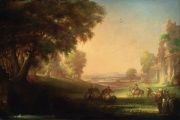Difference between revisions of "Wallboard"
(username removed) |
m (Text replace - "\[http:\/\/cameo\.mfa\.org\/materials\/fullrecord\.asp\?name=([^\s]+)\s(.*)\]" to "$2") |
||
| (One intermediate revision by the same user not shown) | |||
| Line 2: | Line 2: | ||
== Description == | == Description == | ||
| − | Any rigid sheet of material used for covering interior walls and ceilings. Wallboards are used as a substitute for [ | + | Any rigid sheet of material used for covering interior walls and ceilings. Wallboards are used as a substitute for [[plaster|plaster]], as decoration and as quick or temporary support surfaces. Wallboard has been made from a variety of materials over the years. Originally, wallboards were a laminated [[pasteboard|pasteboard]] made from wood pulp, waste paper, [[bagasse|bagasse]], or rags. The paper panels were soaked in linseed oil, dried, then painted or lacquered. In 1926, the Masonite® process for producing a thin, dense [[fiberboard|fiberboard]], or [[hardboard|hardboard]], was developed. A third type of wallboard made from [[gypsum|gypsum]] is called drywall or plasterboard. It is composed of a gypsum core sandwiched between two layers of paper. Gypsum board is fire resistance, dimensionally stable, and inexpensive. Examples of some types of wallboard are: [[beaverboard|beaverboard]]; [[Upson%20board|Upson board]], [[Masonite%C2%AE|Masonite®]]; Iso-board; [[Medex|Medex]], [[particle%20board|particle board]], [[Duron%C2%AE|Duron®]], [[waferboard|waferboard]], [[drywall|drywall]], and [[Sheetrock%C2%AE|Sheetrock®]]. |
== Synonyms and Related Terms == | == Synonyms and Related Terms == | ||
| Line 8: | Line 8: | ||
wall board; gypsum board; drywall; dry-wall; fiberboard | wall board; gypsum board; drywall; dry-wall; fiberboard | ||
| − | == | + | == Sources Checked for Data in Record == |
* G.S.Brady, ''Materials Handbook'', McGraw-Hill Book Co., New York, 1971 Comment: p. 386 | * G.S.Brady, ''Materials Handbook'', McGraw-Hill Book Co., New York, 1971 Comment: p. 386 | ||
Revision as of 13:11, 10 May 2016
Description
Any rigid sheet of material used for covering interior walls and ceilings. Wallboards are used as a substitute for Plaster, as decoration and as quick or temporary support surfaces. Wallboard has been made from a variety of materials over the years. Originally, wallboards were a laminated Pasteboard made from wood pulp, waste paper, Bagasse, or rags. The paper panels were soaked in linseed oil, dried, then painted or lacquered. In 1926, the Masonite® process for producing a thin, dense Fiberboard, or Hardboard, was developed. A third type of wallboard made from Gypsum is called drywall or plasterboard. It is composed of a gypsum core sandwiched between two layers of paper. Gypsum board is fire resistance, dimensionally stable, and inexpensive. Examples of some types of wallboard are: Beaverboard; Upson board, Masonite®; Iso-board; Medex, Particle board, Duron®, Waferboard, Drywall, and Sheetrock®.
Synonyms and Related Terms
wall board; gypsum board; drywall; dry-wall; fiberboard
Sources Checked for Data in Record
- G.S.Brady, Materials Handbook, McGraw-Hill Book Co., New York, 1971 Comment: p. 386
- Ralph Mayer, A Dictionary of Art Terms and Techniques, Harper and Row Publishers, New York, 1969 (also 1945 printing)
- Dictionary of Building Preservation, Ward Bucher, ed., John Wiley & Sons, Inc., New York City, 1996
- Thomas C. Jester (ed.), Twentieth-Century Building Materials, McGraw-Hill Companies, Washington DC, 1995
- Random House, Webster's Encyclopedic Unabridged Dictionary of the English Language, Grammercy Book, New York, 1997
- The American Heritage Dictionary or Encarta, via Microsoft Bookshelf 98, Microsoft Corp., 1998
- Art and Architecture Thesaurus Online, http://www.getty.edu/research/tools/vocabulary/aat/, J. Paul Getty Trust, Los Angeles, 2000
